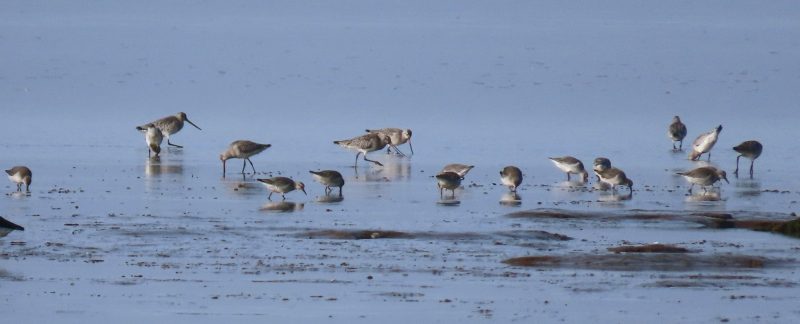Friday 22 February
Alex and Aron headed to Snettisham and Heacham South beaches to recce at first light on Friday morning. Upon arrival at Heacham beach (06:15) there were c. 200 Curlew roosting along the tide edge in a thin line extending along the shore. At Snettisham Aron had c. 300 Oystercatchers. The visibility was initially quite poor due to mist over the coast, but it soon burnt off and an ‘oil slick’ of mainly Oystercatchers was sighted on Heacham South beach. The flock was made up of 2,000+ Oystercatchers, 100+ Sanderling, c. 500 godwits, c. 50 Knot, c. 25 Curlew and 5−10 Ringed Plover.
Cathy headed to Heacham North North and saw an initial 20 Curlew at 06:50, 19 Turnstone and 11 Ringed Plover. Thirty Sanderling were spotted further along towards Heacham. The Curlew flock increased to 30 by 07:00 but was then flushed by a dog walker. At 07:30 a flock of 2−300 Sanderling was present on Heacham North North. In a field behind Heacham Cathy spotted 138 Curlew. After her recce, Cathy headed to Snettisham beach to do some colour ring resighting on the falling tide resulting in one Curlew and three Bar-tailed Godwit sightings (all WWRG schemes).
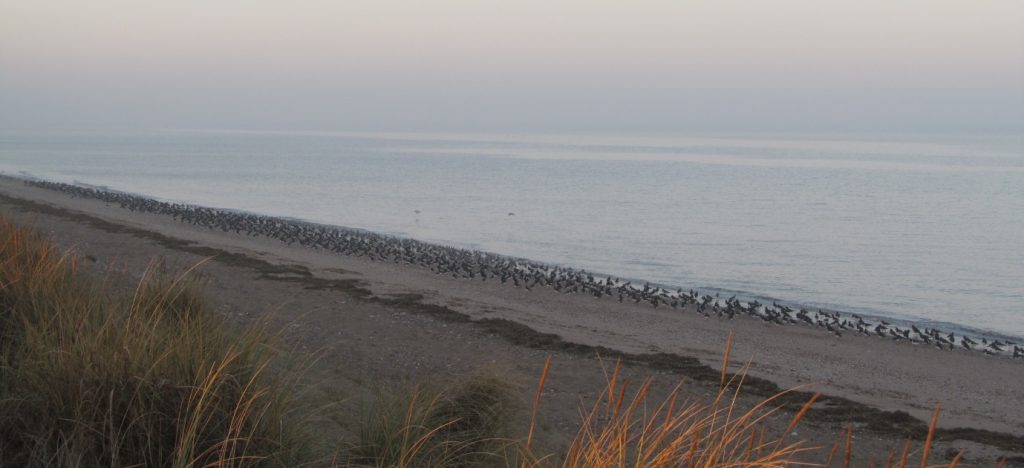
Following the morning recces it was decided that two small-mesh nets would be set on Heacham South beach to target Oystercatchers. The ground had dried out since the January catching trip and all vehicles drove in and out of the site without any slippery mud incidents.
Saturday 23 February
The hide team of Nigel, Ryan and Gary were in position before first light, with the rest of the team in position at base camp by 06:00. Due to the profile of the beach, incoming tide and the time of first light, the team knew it was likely to be a case of catching shortly after dawn, probably without a countdown, so base camp was braced for action. It wasn’t quite a first-light catch, with the tide not being as high up the beach as anticipated, but once the flock was in the catching area a good catch of 189 Oystercatchers was taken at 06:55.
| Species | New | Retrap | Total |
| Oystercatcher | 163 | 26 | 189 |
| Total | 163 | 26 | 189 |
While the team was dealing with Oystercatchers at Heacham South beach, Rob was resighting and doing a recce at Heacham North North. Thirty colour-marked Curlew were resighted. 160 Sanderling, 25 Ringed Plover and 30 Turnstone were seen along the beach at Heacham North North. Following Rob’s recce, the decision was made to change Sunday morning’s activities from colour-ring resighting trips to a cannon-net catch attempt on Heacham North North targeting Turnstone and Sanderling.
Following kit sorting and napping, some of the team went to Terrington Marsh to set up mist nets for the evening’s catch. The nets were set on the barn pool in their usual U shape of five nets with another two nets in a line by themselves, and on the cannon net pool in an E formation of 12 nets. The nets were already catching as the tape lures were taken out to each pool. The night’s catching was steady, totalling 108 birds with a nice variety of species including Grey Plover, Black-tailed Godwit and Knot.
| Species | New | Retrap | Total |
| Oystercatcher | 4 | 1 | 5 |
| Grey Plover | 1 | – | 1 |
| Knot | 1 | – | 1 |
| Dunlin | 69 | 2 | 71 |
| Black-tailed Godwit | 2 | – | 2 |
| Curlew | 4 | – | 4 |
| Redshank | 21 | 3 | 24 |
| Totals | 102 | 6 | 108 |
Sunday 24 February
The team arrived at Heacham North North for 07:30 in the light of a hazy sunrise. Due to the usual heavy disturbance level of the site and the target species being Turnstone and Sanderling, one small mesh cannon net was set without the cover of darkness. After some twinkling from either end of the beach, a catch was taken at 09:30. The catch was made up of Sanderling, half of which were retraps, Turnstone and a single Dunlin. Out of the 22 Turnstone caught, only two were retraps and only one of those was already colour marked. With 21 newly colour-marked birds, the Turnstone project has certainly been revived.
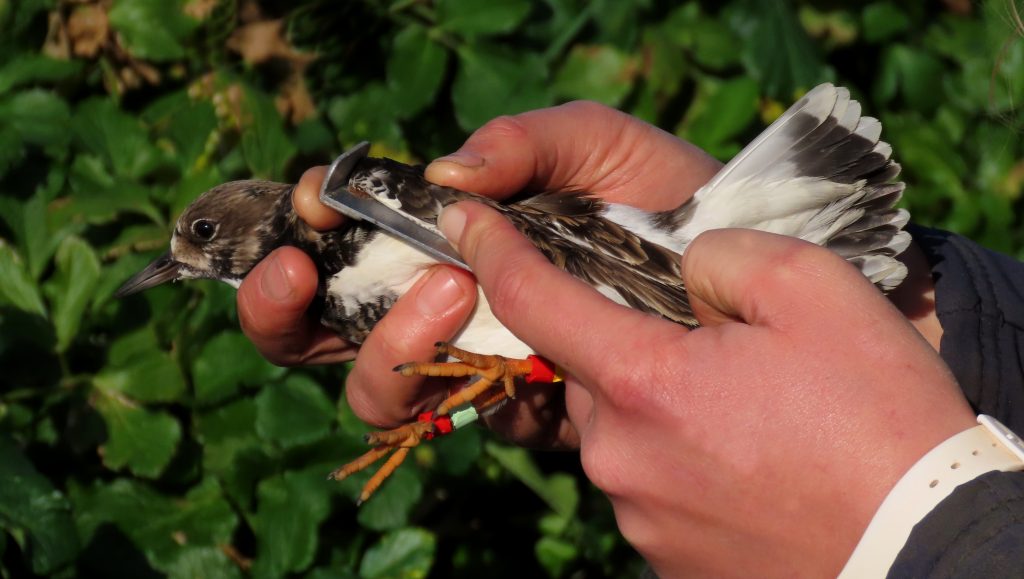
As well as a great catch of Turnstone, the catch was also a definite success in terms of public relations. The team ringed and processed birds along the edge of the promenade and every passerby was engaged with, with no negative responses from the public.
| Species | New | Retrap | Total |
| Sanderling | 32 | 34 | 66 |
| Dunlin | 1 | – | 1 |
| Turnstone | 20 | 2 | 22 |
| Totals | 53 | 36 | 89 |
Throughout the morning the team was treated to some exciting, non-wader sightings; Harbour Porpoise, Common Lizard, Small Tortoiseshell butterfly and a Lapland Bunting flyover. The most exciting fly past of the morning though was at 08:04 when a flock of 12 Bewick’s Swans were spotted, including two birds with WWT collars! These two birds were WWT Slimbridge Bewick’s ‘Elroy’ and ‘Arkadi’ and thanks to the tracking data maps we could see that since our sighting earlier in the morning, they had made their way out into the North Sea on their journey to the breeding grounds.
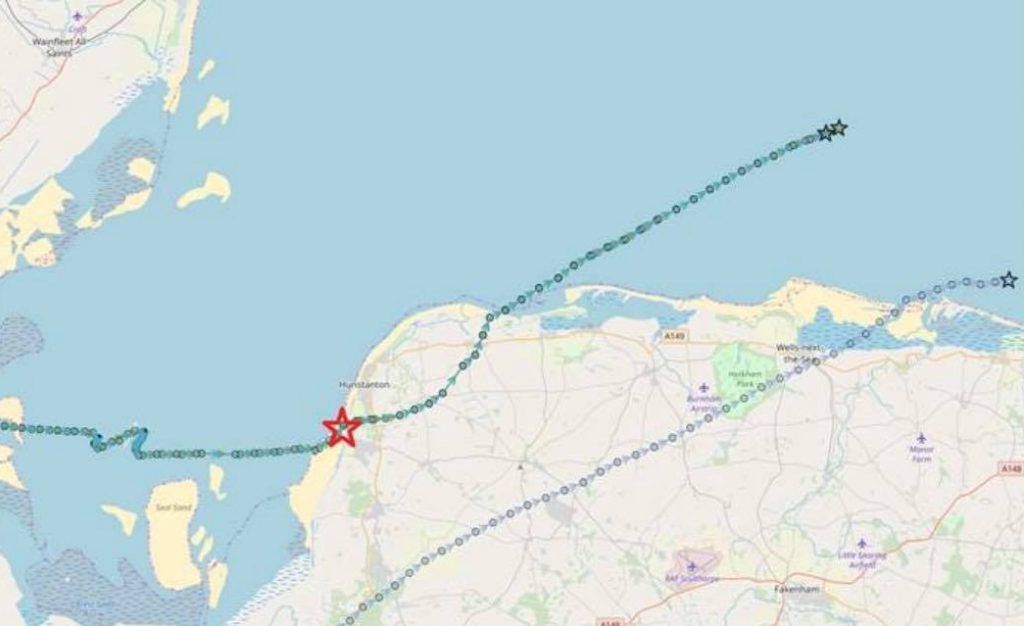
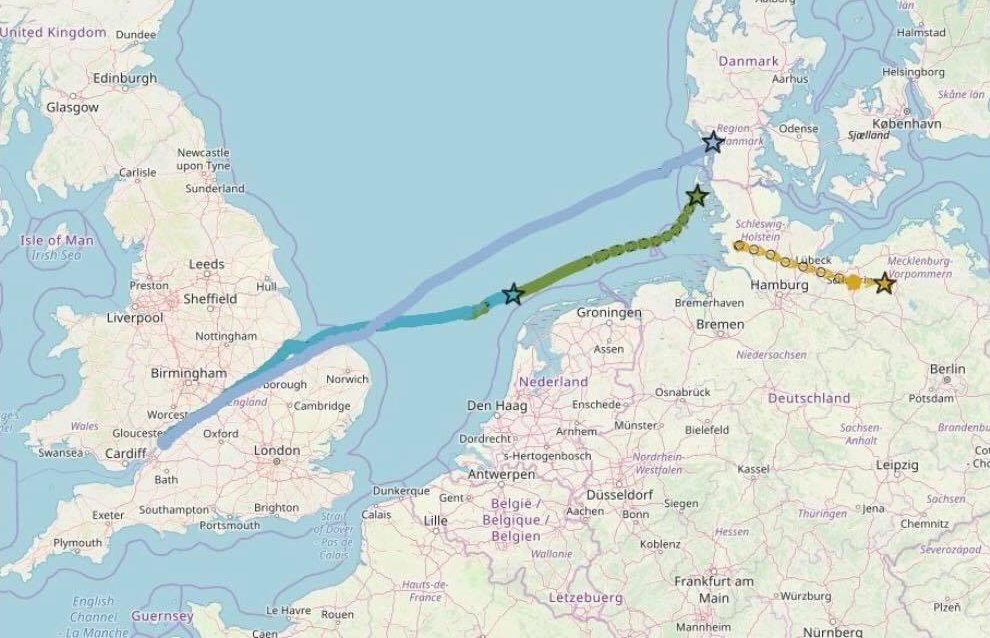
The trip was an excellent last catching weekend of the 2018/19 winter with a great team, glorious sunshine and three successful catches.
Colour ring Resighting
32 Curlew (all WWRG scheme)
3 Bar-tailed Godwit (all WWRG scheme)
1 Turnstone (WWRG scheme)
Final catch totals
| Species | New | Retrap | Total |
| Oystercatcher | 167 | – | 194 |
| Grey Plover | 1 | – | 1 |
| Knot | 1 | – | 1 |
| Sanderling | 32 | 34 | 66 |
| Dunlin | 70 | 2 | 72 |
| Black-tailed Godwit | 2 | – | 2 |
| Curlew | 4 | – | 4 |
| Redshank | 21 | 3 | 24 |
| Turnstone | 20 | 2 | 22 |
| Total | 318 | 41 | 386 |

